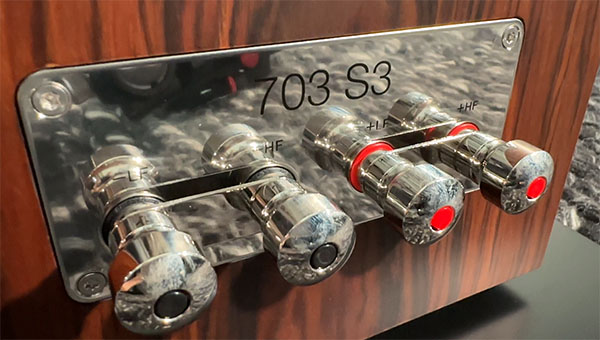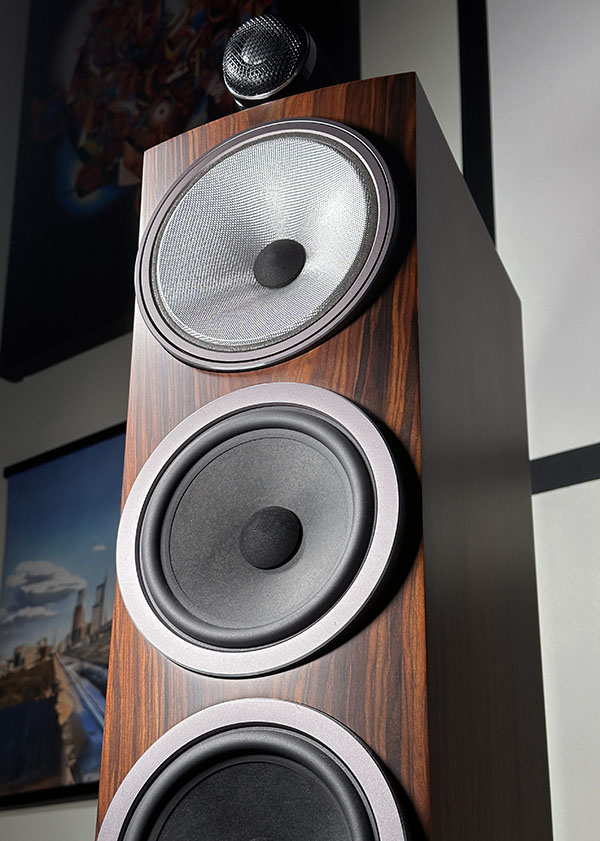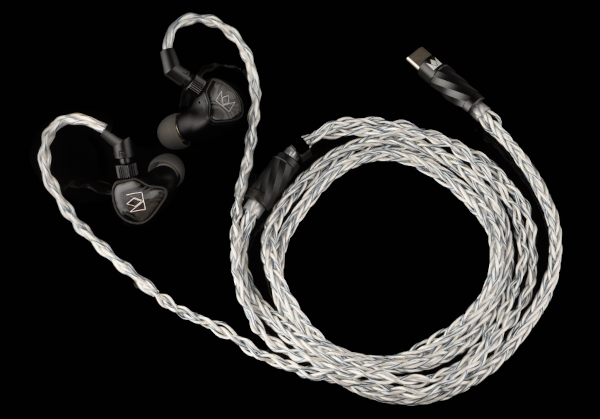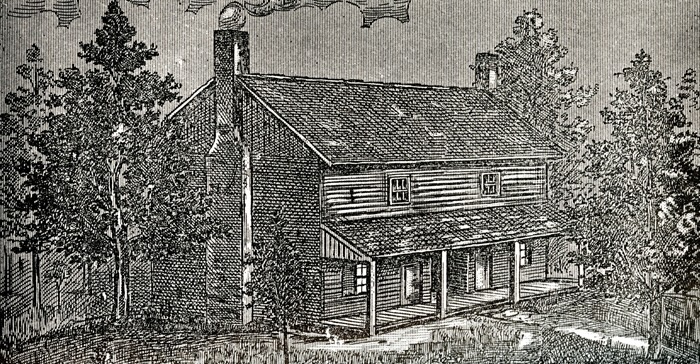Performance Build Quality Value PRICE $3,000 (each) AT A GLANCE Plus Holographic soundstage and imaging Tight and articulate bass Aesthetically pleasing Easy to assemble Minus Somewhat low sensitivity Can't place Atmos modules on top of the towers THE VERDICT...
PRICE $3,000 (each)
AT A GLANCE
Plus
Holographic soundstage and imaging
Tight and articulate bass
Aesthetically pleasing
Easy to assemble
Minus
Somewhat low sensitivity
Can't place Atmos modules on top of the towers
THE VERDICT
Speakers that reveal music's emotional core, allowing you to connect with it on a deeper level.
My experience with Bowers & Wilkins dates back over thirty years to my high school days, when I first admired the 801 Matrix in Stereophile magazine. My longstanding interest in the brand has led me to review products, visit their factory in Worthing, England, and witness their speakers at Abbey Road Studios. Naturally, I was eager to review the 703 S3 towers, both on their own and as as part of a 5.4 (four subwoofer) surround-sound system.
This review is a bit of a mea culpa. Each year since 2012�when Dolby Atmos was introduced�I have favored the benefits of more speakers. Suddenly it was not just 5.1 or 7.1, more speakers were more immersive, right? Just a few months ago I reviewed a 9.4.4 system to get a taste of what it's like to go all-out with a Denon A1H AVR. But for these 703 S3 speakers, I decided to go all the way back to a simple 5.1-channel system for movies and also focus on their capabilities when handling 2-channel music playback duties. The goal, to hear what fewer but better speakers offer versus spending a similar sum on a huge Atmos system.
Features
The new 700 S3 Series from Bowers & Wilkins encompasses a total of eight models. The 703 S3 is the smaller of the two tower models, it has two 6.5-inch bass drivers and a rear-firing port, versus the 702 S3's three bass drivers and down-firing port. A premium high-performance floorstanding loudspeaker, it is equally suitable for a 2-channel stereo system and for multi-channel home theater use.

This speaker is notable for its distinctive 3-way, 4-driver design. At its core, the 703 S3 features a 1" decoupled carbon dome tweeter. The tweeter is isolated in its own compartment that rests on top of the cabinet, a concept pioneered with the 801 matrix that the company refers to as "Tweeter-on-Top."
The midrange frequencies are handled by a 6" decoupled Continuum Cone FST (fixed suspension transducer) driver, which produces smooth and natural vocals thanks to improved flexibility and lower distortion and coloration versus traditional cone designs that employ a conventional spider. For the lower end of the spectrum, dual 6-1/2" Aerofoil Profile drivers, constructed from a stiff, robust foam "sandwich" composite, deliver deep and powerful bass.
With a sensitivity of 90 dB, it takes some power to really get it going, the recommended power range for the 703 S3 is between 30 and 200 watts. However, the 8-ohm rated nominal impedance promises compatibility with a wide range of amplifiers.
On the rear panel, the speaker features dual pairs of gold-plated binding post terminals, accommodating bi-amp or bi-wire configurations. The terminals are compatible with 4mm banana plugs, as well as 6 and 8mm spades, and can also handle bare wires up to 4mm in thickness. A two-piece foam port plug is included, offering users the ability to fine-tune the speaker's low-frequency response.

Attention to detail extends to the speaker's design and convenience features. A magnetically attached, removable grille makes for easy access and cleaning, and the included plinth and carpet spikes provide stability. The 703 S3, measuring 11-7/16"W x 44-7/16"H x 14-5/8"D and weighing 63.5 lbs, is a substantial piece of audio equipment.
Unboxing, Setup and First Impressions
Upon unboxing the 703 S3 Towers, their craftsmanship struck me as not just high-quality�it is luxurious. These visually appealing speakers would fit well in any elegantly decorated room, not limited to dedicated listening areas.
The look of this speaker is unmistakably Bowers & Wilkins. The Mocha wood grain finish complements the rest of the aesthetic. In my opinion, it would be a shame to use a grill on this speaker because the drivers are presented in such an attractive manner, which also happens to be a matter of form following function! Even the packaging impressed me with its ease of handling and robust protection. Assembling the speakers was straightforward, thanks to the solid, bolt-on plinth outfittable with either spikes or rubber feet, enhancing the towers' stability and presence.
In this video I unbox the 703 S3 towers along with the 705 S3 bookshelf and HTM71 S3 center channel speaker.
In this review, the towers served as the left and right channel speakers in a 5.1-channel system. The electronics to power them are the Marantz AV10 preamp/processor paired with a Marantz AMP10 16-channel home theater amplifier. The latter is rated at 200 watts per channel (2 channels driven) into 8 ohms and 400 watts into 4 ohms, making it a perfect match for these towers.
Also in the 5.1-channel, 5.4-speaker configuration is the Bowers & Wilkins HTM71 S3 3-way center channel, a pair of 705 S3 bookshelf speakers, and four DB3D subs. The reason I asked for four subs is that the Marantz AV10 supports up to four discrete subs. Notably, the DB3D's frequency response is rated at 10 Hz - 350 Hz (-3dB), even one of them can turn this into a full-range system. Using four of the subs offers smoother bass response and also makes it possible to play the speaker system to its outer performance limits.
Room Correction
While I consider room correction and EQ a necessity for pretty much any multi-channel system�especially if it integrates one or more subwoofers�another use I have for taking the measurements is seeing how the speakers perform in my room, understanding what the uncorrected response looks like at various seating positions. Measurements are what tell me if the published specs are translating to my at-home experience.

These towers truly do not need EQ or room correction to sound fantastic. If you run them full range and set them up properly you'll certainly have an engrossing listening experience. But even those who eschew any form of correction can benefit from some measurements that reveal the response at the main listening position; you can tweak the response by experimenting with toe-in, placement, and seating position.
But in my view, it is with the judicious application of room correction that things get exciting. The result of running Audyssey with a dozen measurements produced a smooth response in the bass. The midrange and treble already look good, so I used the MultEQ-X software to limit room correction to 300 Hz and below.
For all listening, I left the 703 S3 port unplugged. It is, after all, a ported speaker design, and the port itself works well, not once calling attention to itself. But for listeners who find there is too much bass in an un-EQ'd system, the option is there.
Performance and Listening
The 703 S3 speakers deliver an exceptionally refined soundstage and imaging, adept at crafting a broad aural panorama or honing in on intricate details, depending on the audio mix. In the loft where I live and review gear�a 17 x 35-foot space with 13-foot ceiling�they excel without any need for equalization or other adjustments, just a bit of toe-in. They exemplify high-fidelity audio through their transparency and clarity. Whether transporting listeners into a studio's intimate setting or bringing the vibrancy of a live performance into a room, these speakers capture the essence of both live recordings and studio productions aimed at emulating live ambience.
Their versatility shines in both a 5.1 setup and as a standalone two-channel music system. In multi-channel configurations, they work in harmony with the center channel and other speakers of the 700 S3 line, enhancing the overall holographic transparency. The steering, which is essentially the passing off of sounds from one speaker to another creating the illusion of movement, is seamless. This makes them particularly suitable for listening to complex immersive mixes filled with nuance, including multichannel music and movie soundtracks.
Impressively, they maintain the scale of the soundstage with precision, neither understating nor overstating it. The sound character they present�whether expansive or intimate, dense or sparse, ambient or direct�faithfully reflects the original mix and mastering of the audio content. These speakers consistently distinguish themselves by their ability to reproduce sound accurately, without imparting their own coloration.
During my extensive testing with various music genres and films, the speakers consistently delivered an enveloping and precise sound. They showcased their versatility in handling complex electronic music and movie soundtracks with ease. Their genre-neutrality was particularly evident in the range of content they could flawlessly reproduce.

Because this speaker system and review came immediately after a 9.4.4 Dolby Atmos system from Arendal�that costs less ($15K) than this 5.4 system ($22.5K)�I had plenty of time to think about the benefits of having more speakers for total spatial envelopment versus the benefits of concentrating a budget on fewer, but overall better speakers.
While subjective, I feel strongly that the 5.4 system more often than not provides a superior listening experience than the 9.4.4 system due to each channel being of higher quality. Most impressively, that's even the case for the center channel speaker, the HTM71 S3, which performs like a tower. I thought that I would miss having the extra channels and the Atmos immersion, but� after listening to dozens of movies and hundreds of hours of music now it seems the money�in my opinion anyhow�is better spent concentrated on these fewer speakers.
Music
Listening to the 703 S3s with no EQ, no sub, full range as a true two-channel system is incredibly rewarding. Make no mistake, these speakers stand on their own and really dish it out if you feed them the power they demand, Bassnectar's album The Golden Rule opens with the eponymous track, starting with delicate synth chimes, flawlessly rendered by the 703 S3s. Subwoofers seamlessly join in, pouring out a deep, controlled bass foundation without muddying the pristine highs. The climax hits like a tight, energetic wall of sound, filling the room with energy but not losing focus. The beats are as palpable as they are audible.
The next track "Unlocked" throws down the aural gauntlet with dramatic synth pads and Rye Rye's agile rapping. The 703 S3s deliver her vocals with precision, while the subwoofers add visceral energy. The bass here isn't necessarily deep; it's textured and varied. The towers effortlessly reproduce the complex bass lines, adding depth and dimension that elevate the track to a tactile, highly engaging listening experience.
Feeling the music emerged as a consistent theme with the 703 S3s. This has the almost magical effect of making a live music recording sound like it really is live. Believability is in the micro-textures found in the deeper layers of a mix, rendered here with great verisimilitude.
One of my favorite tests of a speaker's mettle is "Disc Wars" from the Tron: Legacy soundtrack. It's Daft Punk's synths plus the London Philharmonic Orchestra. It's thick, and it is easily diminished by a speaker that can't keep up with the dual demands of a full orchestra and relentless subwoofer-crushing synth bass.
I auditioned the track at live music volume levels three separate times. First with the 703 S3s alone, 2.0, no room correction. Then as a 2.1 system, with just one DB3D pitching in below 40 Hz while the speakers run full range, again no room correction. And then I let loose the big guns and ran all four subs along with the speakers while using a 60 Hz crossover and applying room correction below 300 Hz�which is roughly where room effects start to dominate the bass response. The result? Three distinct presentations, each with its merits.
The 703 S3s on their own sound organic, lucid, painting stunning soundscapes filled with sonic filigrees with ease. The bass is taut and digs deep enough that a sub is not missed. But with measurements, I can see that in-room response tracks what the specs claim, and by 30 Hz or so there's not much left. However, add just one DB3D sub, and you've got a full-range system that plays clean down to 20 Hz and below. You can hear and feel that deeper foundation, but the character of the system is very similar to the subwoofer-free configuration.

And then there's the four-sub system. My kind of system, intense. Scary, even. Granted, four DB3Ds cost $14,000 so they better deliver something profound. And they do. I've never had a system shake me like this with subwoofers so small. With 4,000 watts pushing a total of eight 8-inch drivers, the displacement is there to move the air. End result: I got goosebumps.
Some music demands bass deeper than just about any passive tower can deliver. An example is Rutter's "Requiem: Pie Jesu" as performed by the Turtle Creek Chorale, the Women's Chorus of Dallas. In it are a couple of 20 Hz and one 16 Hz organ note�an infrasonic blast that is utterly clean and incredibly powerful. This is where the four DB3D subs come into play, because the 703 S3 can't play that low. But notably, the track sounds almost the same with and without the subs, except when the organ comes in with the deep notes. Maybe you don't need four DB3Ds for a 2.1 system, but it sure is a nice luxury!
Movies
This is where the mea culpa happened, my realization that fewer but better speakers is a wise(r) path. Granted, with any good system chances are you won't know what you are missing because you'll be enthralled by what you've got. So here's the question: What's more enthralling, more speakers, or fewer but higher fidelity speakers? I can't escape the conclusion that higher fidelity pays the greater dividend.
Now, there certainly are movies that have a lot of overhead Atmos effects, Gravity (2013) is a good example. But unless you fetishize that effect, most of that and just about any other movie revolves around sounds coming from the front, with dialog and soundtrack being key. And to me, that's the key. There's nothing gimmicky about dialog clarity.
I watched a couple dozen movies on the 5.1 system over the course of the review. From Oppenheimer to Barbie to Gran Turismo, what blew me away is the seamlessness of the circle of sound created by the five speakers, and how the HTM71 S3 center channel manages to be as "invisible" as the towers, which is to say that it just blends into the soundscape, it is not localizable. Tonality is maintained off-axis because comb filtering is controlled by the center's three-way design.
When used in home theater, the 703 S3's bass extension is not enough to handle on their own what modern movies demand. The subs are the icing on the cake, because what they deliver�especially after a proper tuning with Dirac Live or Audyssey XT32 (both yield excellent results)�is bass that makes my living room sound and feel like a high-end dedicated home theater.
Conclusion
The Bowers & Wilkins 703 S3 Tower Speakers justify their price through their exceptional performance and aesthetic appeal. They cater to a wide range of audio content with ease, making them a versatile choice for any audio enthusiast. The system's ability to create an immersive soundstage surpasses the need for additional Atmos capabilities.
However, their high cost may be a deterrent for some. For those seeking a more economical option, Bowers and Wilkins offer alternatives in the 600 S3 series that might fit the bill, particularly in home theater setups.
In conclusion, these speakers are an ideal choice for those who value luxury performance. They are a testament to Bowers and Wilkins' commitment to delivering quality in every aspect of their products. Despite their limitation in Atmos integration and a sensitivity rating that requires a powerful amplifier, their overall performance and design excellence make them a highly recommendable investment for the discerning audiophile.
Specs
Description: 3-way, vented-box system.
Drive units: 1x �25mm (1 in) Decoupled Carbon Dome high-frequency.
1x �150mm (6 in) Continuum cone FST midrange.
2x �165mm (6.5 in) Aerofoil Profile bass.
Frequency response: 46Hz - 28kHz �3dB.
Frequency range: 30Hz to 33kHz.
Impedances: Nominal 8?, minimum 3.1?.
Sensitivity: 90dB spl (2.83Vrms, 1m).
Recommended amplification: 30W - 200W into 8?.














